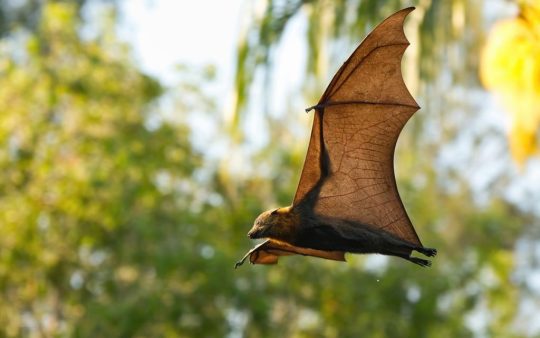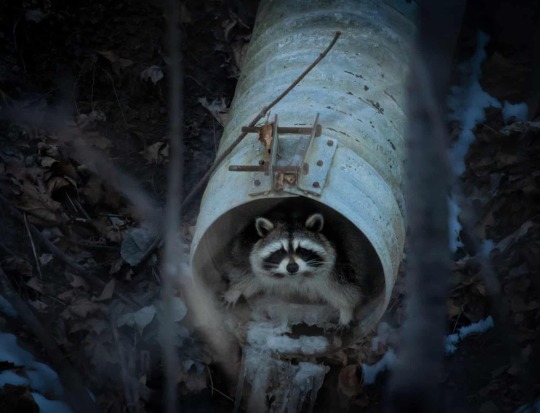#urban mammals
Explore tagged Tumblr posts
Text



Get Foxy with the Grey-headed Flying Fox
Pteropus poliocephalus, better known as grey-headed flying foxes, are a species of megabat native to eastern Australia. They are typically found in rainforests, woodlands, and swamps, but they have also become common in more agricultural and urban areas, particularly those that maintain large groves of trees. They are semi-migratory, moving when food availability diminishes, and can travel over 1000 km (620 mi) over the course of a season.
Like most bats, grey-headed flying foxes forage at night. They feed exclusively on fruit, pollen, nectar, and tree bark-- most commonly from figs and two species of eucalyptus tree-- and may fly up to 50 km (31 mi) in a single night to find food. Although they are quite large, P. poliocephalus can fall prey to eagles, goannas and snakes, particularly as pups or juveniles.
Because they do not feed on insects, these bats do not use echolocation to navigate. Instead, they use a large range of calls to communicate with other members of their colony, which can contain several hundred members in the summer. Winter colonies are slightly smaller, and segregated by sex, but individuals and families within these groups will stay together for several generations.
Mating occurs between March and May, when males stake out territories and compete to attract females. After mating, mothers seclude themselves in a female-only colony and gestate a singe pup about 6 months after breeding. Weaning takes an additional 5-6 months, after which juveniles separate from their mother. Daughters typically stay within their mother's winter colony, while sons join the male colony after a year's time. Individuals take approximately 30 months to become fully mature, and may live up to 10 years in the wild.
The grey-headed flying fox is notable for being the largest of Australia's bat species. Adults can be anywhere from 600-1000 g (21.5- 35.2 oz), with a wingspan of up to 1 m (3.3 ft). As their name implies, the body is covered with burnt orange fur, and the face is large and fox-like, with none of the large ears or distinct nasal apparatuses that distinguish other bat species.
Conservation status: P. poliocephalus is considered Vulnerable by the IUCN. Populations are declining largely due to habitat destruction. Many individuals are also killed by farmers, who consider them to be pests.
Photos
Vivien Jones
Shane Ruming
Andrew Mercer
#grey-headed flying fox#Chiroptera#Pteropodidae#fruit bats#flying foxes#bats#mammals#tropical forests#tropical forest mammals#tropical rainforests#tropical rainforest mammals#deciduous forests#deciduous forest mammals#urban fauna#urban mammals#oceania#australia#east australia#biology#zoology#ecology#animal facts
83 notes
·
View notes
Text
How many coyotes have YOU seen today?
0 notes
Text

I've been told the photo is not ruined, it's just artistic.
Rotfuchs (red fox) im Büsnauer Wiesental, Vaihingen.
#rotfuchs#red fox#fox#wildlife#animals#mammals#zorro#nature#urban wildlife#stuttgart#germany#wildlife photography#photographers on tumblr#my photography
224 notes
·
View notes
Text



Coyote Canis latrans
1/21/2024 Los Angeles County, California
Tracy Drake via iNaturalist, CC-BY-NC
---
This gorgeous 'yote appears to have heterochromia!
#coyote#coyotes#other people's photos#inaturalist#wildlife#urban wildlife#heterochromia#animals#mammals#canine#canines
155 notes
·
View notes
Text

Toronto's unofficial official animal
184 notes
·
View notes
Text

This delightful image captures a young rabbit resting quietly in the lush green grass, blending seamlessly into its natural surroundings. The soft sunlight filtering through the trees creates a peaceful atmosphere, highlighting the rabbit’s fur and its distinct white tail. This serene moment of wildlife in an urban environment reminds us of the quiet presence of nature around us, even in the most unexpected places.
#Wildlife#Rabbit#Bunny#Nature#Urban Wildlife#Small Mammals#Wildlife Photography#Nature Photography#Colorado Wildlife#MissedMileMarkers
87 notes
·
View notes
Photo

Trash Panda
A raccoon peeks out from a drain pipe in Toronto
Photograph: Jill Finney/Picfair
Urban Wildlife Photography Awards 2022
#jill finney#photographer#picfair#raccoon#urban photography#mammal#wildlife#animal#nature#toronto#urban wildlife photography awards
243 notes
·
View notes
Text
9 notes
·
View notes
Video
Lioness with a baby warthog in the mouth, Samburu County, Samburu National Reserve, Kenya by Eric Lafforgue Via Flickr: © Eric Lafforgue www.ericlafforgue.com
#Africa#Animal#Animal themes#Animals in the wild#Beauty in nature#Carnivora#Colour image#Day#East africa#Environment#Food#Full lenght#Hunt#Hunting#Kenya#Kenya-23-318#Lion#Lioness#Mammal#National park#National reserve#Nature#No people#Non-urban scene#Outdoors#Panthera leo#Rainy season#Safari#Safari animals#Samburu
3 notes
·
View notes
Text
youtube
Tierzoo is making Death Battle with prehistoric creatures, I can't see this backfiring at all!
#paleoblr#can I get an accuracy check?#awesomebro#paleontology#video#Tierzoo#Utahraptor being the same weight as Smilodon doesn't seem right to me...#Apparently Awesomebro is in Urban dictionary and Know Your Meme. Good job guys!#Utahraptor#Smilodon#cats#carnivora#placentals#mammals#dromeosaur#raptor#theropod#dinosaur#animalia#animation#palaeontology#prehistory#death battle#awesome bro#awesomebro bait#youtube#Youtube
9 notes
·
View notes
Text
Would love to find a resource about the behavior of suburban whitetail deer that isn’t focused on hunting or protecting your garden
I want understand how my neighbors are adapting not fucking murder them
#i have two deer that visit#like 1-2 a week#i just want to know observed paaterns in urban populations vs rural#do certain types of infrastructure change their ranges?#apparently they winter in the pines around here#so do they have a set ‘most cover route out the city’?#their social structures along with established seasonal changes in those behaviors#is absolutely fascinating#160lb mammals enacting telenovelas in your backyard
2 notes
·
View notes
Text



Come Have a Bite with the Vampire Bat!
Desmodus rotundus, better known as the common vampire bat, is a species of leaf-nosed bat native to Central and South America, as well as parts of the Caribbean. They are found primarily in tropical forests, particularly rainforests, but can also roam into scrubland and agricultural areas. Common vampire bats roost in hollow trees, caves, and abandoned buildings, making them a common sight in or near urban areas.
As their name implies, the common vampire bat feeds exclusively on blood, particularly those of mammals. In the wild they will feed on large animals like tapirs, but they more frequently go after domesticated animals like cattle, goats, and horses. However, when ideal prey is lacking they will also feed off lizards, turtles, snakes, toads, and crocodiles. Like most bats, D. rotundus uses echolocation to find prey. Then, special heat sensors in the nose help it to detect blood vessels close to the skin; it then bites open a small flap of the skin and drinks its fill. Its saliva contains both painkillers and anticoagulents, so victims seldom notice their host until after it has fed. Predators of D. rotundus include owls, hawks, and eagles.
Common vampire bats live in colonies of about 100 individuals, although colonies consisting of up to 1,000 individuals have been recorded. Within these colonies, males and females roost separately; females cluster in groups of 8-20, while males roost individually and guard territories against other males. However, D. rotundus is highly social, and males and females will both groom members of the same and opposite sex. This grooming can even extend to homosexual behaviours like genital licking, which is thought to reinforce hierarchies and strengthen social bonds.
D. rotundus can breed year-round, but females only raise one pup per year. Males typically mate with females in or near their defended territories. Afterwards, females carry their pregnancy for about 7 months before giving birth to a single pup. These young feed on their mother's milk for their first month; during this time, other adult females will often provide the mother with excess blood as she cannot hunt for herself. Once the pup is weaned they begin recieving blood from their mothers, and at four months they begin accompanying her on hunts. At about five months they are fully independent; females will remain in their mother's roost while males will leave to establish their own territories. Young become fully mature at about a year old, and adults may live to 12 years in the wild.
The common vampire bat is relatively plain looking, as far as bats go. They are generally gray or brown, with darker fur over their backs and dark brown or black membranes along their wings. The nose has a distinct triangle shape, which houses special heat-sensing organs. Likewise, the ears are large and triangular, used for echolocation. Adults are rather small, about 9 cm (3.5 in) long with an average wingspan of 18 cm (7 in) and a weight of 25–40 grams (2 oz).
Conservation status: The IUCN lists D. rotundus as Least Concern. In fact, populations of the common vampire bat are increasing due to the abundance of livestock as a food source.
If you like what I do, consider buying me a ko-fi!
Photos
Jose Gabriel Martinez Fonseca
Sheri & Brock Fenton
Nicolas Reusens
#common vampire bat#Chiroptera#Phyllostomidae#vampire bats#leaf-nosed bats#bats#mammals#tropical forests#tropical forest mammals#tropical rainforests#tropical rainforest mammals#urban fauna#urban mammals#central america#south america#queer fauna#nature is queer#animal facts#biology#zoology#ecology
223 notes
·
View notes
Video
Kandachime Horse by Katsuaki Shoda Via Flickr: Canon EOS Mark III + Zeiss Makro-Planar T* 2/100 ZE
#Higashidorimura#Aomori#Japan#Horse#No People#Animal Themes#Animal#Animals In The Wild#Nature#Travel#Travel Destinations#Copy Space#Animal Wildlife#Tranquil Scene#Living Organism#Mammal#Horse Family#Local Landmark#Grass Area#Pasture#Scenics - Nature#Beauty In Nature#Non-Urban Scene#Grazing#Grass#Free Range#flickr
1 note
·
View note
Text



Grey squirrel (Sciurus carolinensis) in my local park. He just found something to eat when me and my dog approached, so he took shelter in the bush where he could eat in peace.
I'm growing fond of these guys even if they are invasive in my area.
#squirrels#kermit .jpg#urban wildlife#in the next few years I want to document all mammal and bird species in my area#and maybe publish an inaturalist guide#we'll see
0 notes
Text

One of 2 minks that were squabbling at Ashbridge's Bay Park yesterday
96 notes
·
View notes

